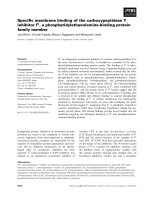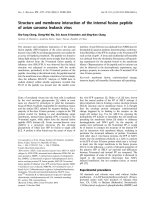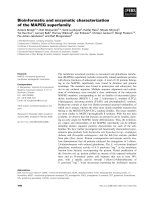Báo cáo khoa học: "Maximum Entropy Model Learning of the Translation Rules" pot
Bạn đang xem bản rút gọn của tài liệu. Xem và tải ngay bản đầy đủ của tài liệu tại đây (383.44 KB, 5 trang )
Maximum Entropy Model Learning of the Translation Rules
Kengo Sato and Masakazu Nakanishi
Department of Computer Science
Keio University
3-14-1, Hiyoshi, Kohoku, Yokohama 223-8522, Japan
e-mail: {satoken, czl}@nak, ics. keio. ac. jp
Abstract
This paper proposes a learning method of
translation rules from parallel corpora. This
method applies the maximum entropy prin-
ciple to a probabilistic model of translation
rules. First, we define feature functions
which express statistical properties of this
model. Next, in order to optimize the model,
the system iterates following steps: (1) se-
lects a feature function which maximizes log-
likelihood, and (2) adds this function to the
model incrementally. As computational cost
associated with this model is too expensive,
we propose several methods to suppress the
overhead in order to realize the system. The
result shows that it attained 69.54% recall
rate.
1 Introduction
A statistical natural language modeling can
be viewed as estimating a combinational dis-
tribution X x Y -+ [0, 1] using training data
(xl, yl>, , <XT, YT> 6 X. x Y
observed in
corpora. For this topic, Baum (1972) pro-
posed EM algorithm, which was basis of
Forward-Backward algorithm for the hidden
Markov model (HMM) and Inside-Outside
algorithm (Lafferty, 1993) for the pr0babilis-
tic context free grammar (PCFG). However,
these methods have problems such as in-
creasing optimization costs which is due to
a lot of parameters. Therefore, estimating a
natural language model based on the max-
imum entropy (ME) method (Pietra et al.,
1995; Berger et al., 1996) has been high-
lighted recently.
On the other hand, dictionaries for multi-
lingual natural language processing such as
the machine translation has been made by
human hand usually. However, since this
work requires a great deal of labor and it
is difficult to keep description of dictionar-
ies consistent, the researches of automatical
dictionaries making for machine translation
(translation rules) from corpora become ac-
tive recently (Kay and RSschesen, 1993; Kaji
and Aizono, 1996).
In this paper, we notice that estimating
a language model based on ME method is
suitable for learning the translation rules,
and propose several methods to resolve prob-
lems in adapting ME method to learning the
translation rules.
2 Problem Setting
If there exist (xl, Yl>, ,
{XT, YT) 6 X × Y
such that each xi is translated into Yi in
the parallel corpora X,Y, then its empiri-
cal probability distribution/5 obtained from
observed training data is defined by:
p(x,y) - c(x,y) (1)
Ex, c(x,y)
where
c(x, y)
is the number of times that x
is translated into y in the training data.
However, since it is difficult to observe
translating between words actually,
c(x, y)
is
approximated with equation (2) for sentence
aligned parallel corpora.
<(x,y)
c(x, y) =
T
(2)
where X~ is i-th sentence in X. We denote
that sentence Xi is translated into sentence
Y/ in aligned parallel corpora. And
c~(x, y)
1171
is the number of times that x and y appear
in the i-th sentence.
Our task is to learn the translation rules
by estimating probability distribution
p(yI x)
that x E X is translated into y E Y from
15(x, y) given above.
3 Maximum Entropy Method
3.1 Feature Function
We define binary-valued indicator function
f : X × Y -+ {0,1} which divide X x Y
into two subsets. This is called
feature func-
tion,
which expresses statistical properties of
a language model.
The expected value of f with respected to
iS(x, y) is defined such as:
p(f) = p(x,y)f(x,y) (z)
x,y
Thus training data are summarized as the
expected value of feature function f.
The expected value of a feature function
f with respected to
p(yl x)
which we would
like to estimate is defined such as:
p(f) = y~fi(x)p(ylx)f(x,y )
(4)
x,y
where 15(x) is the empirical probability dis-
tribution on X. Then, the model which we
would like to estimate is under constraint to
satisfy an equation such as:
p(f)
=iS(f) (5)
This is called
the constraint equation.
3.2 Maximum Entropy Principle
When there are feature functions
fi(i E
{1, 2, , n}) which are important to model-
ing processes, the distribution p we estimate
should be included in a set of distributions
defined such as:
C = {p E 7 9 I P(fi)
=16(fi) for i E {1,2, ,n}}
(6)
where P is a set of all possible distributions
onX×Y.
For the distribution p, there is no assump-
tion except equation (6), so it is reason-
able that the most uniform distribution is
the most suitable for the training corpora.
The conditional entropy defined in equa-
tion (7) is used as the mathematical measure
of the uniformity of a conditional probability
p(ylx).
H(p) = - y~(x)p(ylx ) logp(ylx )
(7)
x,y
That is, the model
p.
which maximizes the
entropy H should be selected from C.
p. argmax
H(p)
(S)
pet
This heuristic is called
the maximum entropy
principle.
3.3 Parameter Estimation
In simple cases, we can find the solution
to the equation (8) analytically. Unfortu-
nately, there is no analytical solution in gen-
eral cases, and we need a numerical algo-
rithm to find the solution.
By applying the Lagrange multiplier to
equation (7), we can introduce the paramet-
ric form of p.
1
Px(YIx)- Z>,(x)
exp
hifi(x,y)
(9)
Z,x(x) = y~ exp (~,~ifi(x,y))
Y
where each hi is the parameter for the fea-
ture
fi. P~
is known as
Gibbs distribution.
Then, to solve
p. E C
in equation (8) is
equivalent to solve h. that maximize the log-
likelihood:
= - (x)log zj,(z) +
x i
(10)
h. = argmax kV(h)
Such h. can be solved by one of the nu-
merical algorithm called
the Improved Itera-
tire Scaling Algorithm
(Berger et al., 1996).
1. Start with hi = 0 for alli E {1,2, ,n}
2. Do for each i E {1,2, ,n}:
1172
(a) Let AAi be the solution to
~-~(x)p(ylx)$i(x,y)exp (AAif#(x,y)) = P(fi)
x~y
(11)
where
f#(x,y) = Ei~=t f~(x,y)
(b) Update the value of Ai according to:
Ai ~- A~ + AAi
4 Maximum Entropy Model
Learning of the Translation
Rules
The art of modeling with the maximum en-
tropy method is to define an informative
set of computationally feasible feature func-
tions. In this section, we define two models
of feature functions for learning the transla-
tion rules.
3. Go to step 2 if not all the Ai have con-
verged
To solve AAi in the step (2a), the Newton's
method is applied to equation (11).
3.4 Feature Selection
In general cases, there exist a large collec-
tion ~" of candidate features, and because
of the limit of machine resources, we can-
not expect to obtain all iS(f) estimated in
real-life. However, the Maximum Entropy
Principle does not explicitly state how to se-
lect those particular constraints. We build a
subset S C ~" incrementally by iterating to
adjoin a feature f E ~" which maximizes log-
likelihood of the model to S. This algorithm
is called
the Basic Feature Selection
(Berger
et al., 1996).
Model 1: Co-occurrence Information
The first model is defined with co-occurrence
information between words appeared in the
corpus X.
{ 1 (x e W(d,w))
(12)
fw(x,y)
= 0 (otherwise)
where
W(d,w)
is a set of words which ap-
peared within d words from w E X (in our
experiments, d = 5).
fw(x,y)
expresses the
information on w for predicting that x is
translated into y (Figure 1).
W X ~'X
pred~cti~
power" "/translation role
y ~ Y
1. Start with S = O
Figure 1: co-occurance information
.
Do for each candidate feature f E ~':
Compute the model
Psus
using Improve
Iterative Scaling Algorithm and the
gain in the log-likelihood from adding
this feature
Model 2: Morphological Information
The second model is defined with morpho-
logical information such as part-of-speech.
3. Check the termination condition
4. Select the feature ] with maximal gain
5. Adjoin f to S
6. Compute
Ps
using Improve Iterative Al-
gorithm
7. Go to Step 2
{ l osxtl
ft,s(x,
Y) = 1 and
POS(y) s
0 (otherwise)
(13)
where
POS(x)
is a part-of-speech tag for x.
ft,u(x, y)
expresses the information on part-
of-speech t, s for predicting that x is trans-
lated into y (Figure 2). If part-of-speech tag-
1173
t - eos
predictive ~"/x ~'-X
power _ " l
~'~'Jtranslation mle
y ,.y
Figure 2: morphological information
gers for each language work extremely ac-
curate, then these feature functions can be
generated automatically.
5 Implementation
Computational cost associated with the
model described above is too expensive to
realize the system for learning the transla-
tion rules. We propose several methods to
suppress the overhead.
An estimated probability
p~(yI x)
for a pair
of (x,y) E X x Y which has not been ob-
served as the sample data in the parallel
corpora X,Y should be kept lower. Ac-
cording to equation (9), we can allow to let
fi(x,y)
= 0 (for all i E {1, ,n}) for non-
observed (x, y). Therefore, we will accept
observed (x, y) only instead of all possible
(x, y) in summation in equation (11), so that
p~(ylx)
can be calculated much more effi-
ciently.
Suppose that a set of (x, y) such that each
member activates a feature function f is de-
fined by:
D(f)=
{(x,y) eX×rlf(x,y)=
1} (14)
Shirai et al. (1996) showed that if
D(fi)
and
D(fj)
were exclusive to each other, that is
D(fi) fq
D(fj)
= O, then Ai and Xj could
be estimated independently. Therefore, we
can split a set of candidate feature functions
.T" into several exclusive subsets, and calcu-
late
Px(YlX)
more efficiently by estimating on
each subset independently.
6 Experiments and Results
As the training corpora, we used 6,057 pairs
of sentences included in Kodansya Japanese-
English Dictionary, a machine-readable dic-
tionary made by the Electrotechnical Lab-
oratory. By applying morphological anal-
ysis for the corpora, each word was trans-
formed to the infinitive form. We excluded
words which appeared below 3 times or over
1,000 times from the target of learning. Con-
sequently, our target for the experiments
included 1,375 English words and 1,195
Japanese words, and we prepared 1,375 fea-
ture functions for model 1 and 2,744 for
model 2 (56 part-of-speech for English and
49 part-of-speech for Japanese).
We tried to learn the translation rules
from English to Japanese. We had two ex-
periments: one of model 1 as the set of fea-
ture functions, and one of model 1 + 2. For
each experiment, 500 feature functions were
selected according to the feature selection
algorithm described in section 3.4, and we
calculated
p(yI x)
in equation (9), that is,
the probability that English word x is trans-
lated into Japanese word y. For each English
word, all Japanese word were ordered by es-
timated probability
p(yix),
and we evaluated
the recall rates by comparing the dictionary.
Table 1 shows the recall rates for each ex-
periment. The numbers for 15(x,y) are the
Ta )le 1: rec
1st
y) 44.55%
model 1 41.58%
model 1 +2 58.29%
dl rates
-~ 3rd
53.47%
63.37%
69.54%
,-~ 10th
58.42%
76.24%
80.13%
recall rates when the empirical probability
defined by equation (1) was used instead of
the estimated probability. It is showed that
the model 1 + 2 attains higher recall rates
than the model 1 and ~(x, y).
Figure 3 shows the log-likelihood for each
model plotted by the number of feature func-
tions in the feature selection algorithm. No-
tice that the log-likelihood for the model 1+2
is always higher than the model 1.
Thus, the model 1 + 2 is more'effective
than the model 1 for learning the translation
rules.
However, the result shows that the recall
1174
+9.02
-9.04
.11.06
*&08
-Ik12
-&14
-9.14
.9.16
I I I I I I I I I
50 100 1~0 290 2~ ~0 350 400 ~ 500
Ihe nun~ od ~t~ll
Figure 3: log-likelihood
rates of the '1st' for all models are not fa-
vorable. We consider that it is the reason
for this to assume word-to-word translation
rules implicitly.
7 Conclusions
We have described an approach to learn the
translation rules from parallel corpora based
on the maximum entropy method. As fea-
ture functions, we have defined two mod-
els, one with co-occurrence information and
the other with morphological information.
As computational cost associated with this
method is too expensive, we have proposed
several methods to suppress the overhead in
order to realize the system. We had experi-
ments for each model of features, and the re-
sult showed the effectiveness of this method,
especially for the model of features with co-
occurrence and morphological information.
Acknowledgments
We would like to thank the Electrotechni-
cal Laboratory for giving us the machine-
readable dictionary which was used as the
training data.
References
L. E. Baum. 1972. An inequality and associ-
ated maximumization technique in statis-
tical estimation of probabilistic functions
of a markov process.
Inequalities,
3:1-8.
Adam L. Berger, Stephen A. Della Pietra,
and Vincent J. Della Pietra. 1996. A max-
imum entropy approach to natural lan-
guage processing.
Computational Linguis-
tics,
22(1):39-71.
Hiroyuki Kaji and Toshiko Aizono. 1996.
Extracting word correspondences from
bilingual corpora based on word co-
occurrence information. In
Proceedings
of the 16th International Conference on
Computational Linguistics,
pages 23-28.
M. Kay and M. RSschesen. 1993. Text
translation alignment.
Computational
Linguistics,
19(1):121-142.
J. D. Lafferty. 1993. A derivation of the
inside-outside algorithm from the EM al-
gorithm.
IBM Research Report.
IBM T.J.
Watson Research Center.
Stephen Della Pietra, Vincent Della Pietra,
and John Lafferty. 1995. Inducing fea-
tures of random fields. Technical Report
CMU-CS-95-144, Carnegie Mellon Univer-
sity, May.
Adwait Ratnaparkhi. 1997. A linear ob-
served time statistical parser based on
maximum entropy models. In
Proceedings
of Second Conference On Empirical Meth-
ods in Natural Language Processing.
Jeffrey C. Reynar and Adwait Ratnaparkhi.
1997. A maximum entropy approach to
identifying sentence boundaries. In
Pro-
ceedings of the 5th Applied Natural Lan-
guage Processing Conference.
Ronald Rosenfeld. 1996. A maximum en-
tropy approach to adaptive statistical lan-
guage modeling.
Computer, Speech and
Language,
(10):187-228.
Kiyoaki Shirai, Kentaro Inui, Takenobu
Tokunaga, and Hozumi Tanaka. 1996.
A maximum entropy model for estimat-
ing lexical bigrams (in Japanese). In
SIG
Notes of the Information Processing Soci-
ety of Japan,
number 96-NL-116.
Takehito Utsuro, Takashi Miyata, and Yuji
Matsumoto. 1997. Maximum entropy
model learning of subcategorizatoin pref-
erence. In
Proceedings of the 5th Work-
shop on Very Large Corpora,
pages 246-
260, August.
1175









